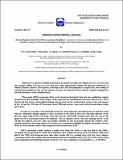Por favor, use este identificador para citar o enlazar a este item:
http://hdl.handle.net/10261/328196COMPARTIR / EXPORTAR:
 SHARE
BASE SHARE
BASE
|
|
| Visualizar otros formatos: MARC | Dublin Core | RDF | ORE | MODS | METS | DIDL | DATACITE | |

| Título: | A Revised Update of the 2014 ASPIC Assessment of Redfish (S. mentella and S. fasciatus) in Divisions 3LN (how the the stock is coping with the actual Management Strategy and its likely impact on the next coming years). |
Autor: | Ávila-de-Melo, Antonio; Brites, Nuno; Alpoim, Ricardo; González-Troncoso, Diana CSIC ORCID; González-Costas, Fernando; Fomin, Konstantin | Palabras clave: | Centro Oceanográfico de Vigo Pesquerías |
Fecha de publicación: | 3-jun-2016 | Citación: | NAFO Scientific Council Research (SCR) Documents, NAFO SCR Doc.16/33, Serial No. N6576. 2016: 1-69 | Resumen: | There are two species of redfish in Divisions 3L and 3N, the deep-sea redfish (Sebastes mentella) and the Acadian redfish (Sebastes fasciatus) that have been commercially fished and reported collectively as redfish in fishery statistics. Both species, occurring on Div. 3LN and managed as a single stock, don’t belong to isolated local populations but, on the contrary, are part of a large Northwest Atlantic complex ranging from the Gulf of Maine to south of Baffin Island. The present ASPIC assessment of this stock is based on the logistic form of a non-equilibrium surplus production model (Schaeffer, 1954; Prager, 1994), adjusted to a standardized catch rate series (Power, 1997) and, for the first time, to all stratified-random bottom trawl surveys conducted in various years and seasons in Div. 3L and Div. 3N from 1978 onwards. Both CPUE and surveys were used with all observations within each series. In order to proceed on the threshold of the new 2014 approach, and taking into account that since then no substantial changes appear to have occurred on the state of the stock, the main features of the previous input framework were kept, with MSY fixed at 1960-1985 average catch and the rest of the approved 2014 assessment framework updated. The 3L Spanish survey, the only ongoing survey so far outside the analysis, has now been successfully included on this assessment framework (relative inter-quartile range from bootstrap analysis for the last two assessments highlight the higher consistence of most of the 2016 assessment results when compared with the ones from 2014). ASPIC assessment results confirm a stable stock from the 1960’s to the first half of the 1980’s, sustaining an average yield of 21 000t. Stock declined with a sudden rise of the catch over the late 1980’s first half of the 1990, and increased since then, after catches fell to a residual level with the stock collapse. Assessment results also confirm that the maximum observed sustainable yield (MSY) of 21 000 t can be a long term sustainable yield if fishing mortality stands at 0.11/year, exploiting a correspondent Bmsy at 190 000 t. 2 There is a very high probability that the stock was at the beginning of 2016 at or above Bmsy , after crossing 2015 under a fishing mortality most likely at or below 50% Fmsy. There is also a very high probability that catch on 2016 at 10 400 t TAC and on 2017 and 2018 at the predicted increases approved in the 2014 Risk‐Based Management Strategy for 3LN Redfish, will keep fishing mortality on 2018 below Fmsy and biomass at the beginning of 2019 above Bmsy. | Versión del editor: | http://www.nafo.int/publications/frames/sc-docs.html | URI: | http://hdl.handle.net/10261/328196 |
| Aparece en las colecciones: | (IEO) Artículos |
Ficheros en este ítem:
| Fichero | Descripción | Tamaño | Formato | |
|---|---|---|---|---|
| scr16-033.pdf | 1,03 MB | Adobe PDF |  Visualizar/Abrir |
CORE Recommender
Este item está licenciado bajo una Licencia Creative Commons

